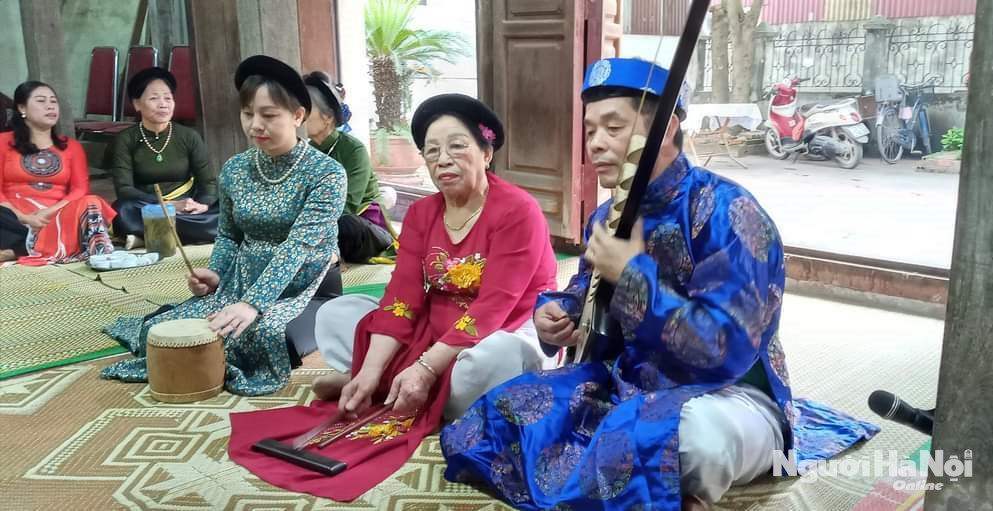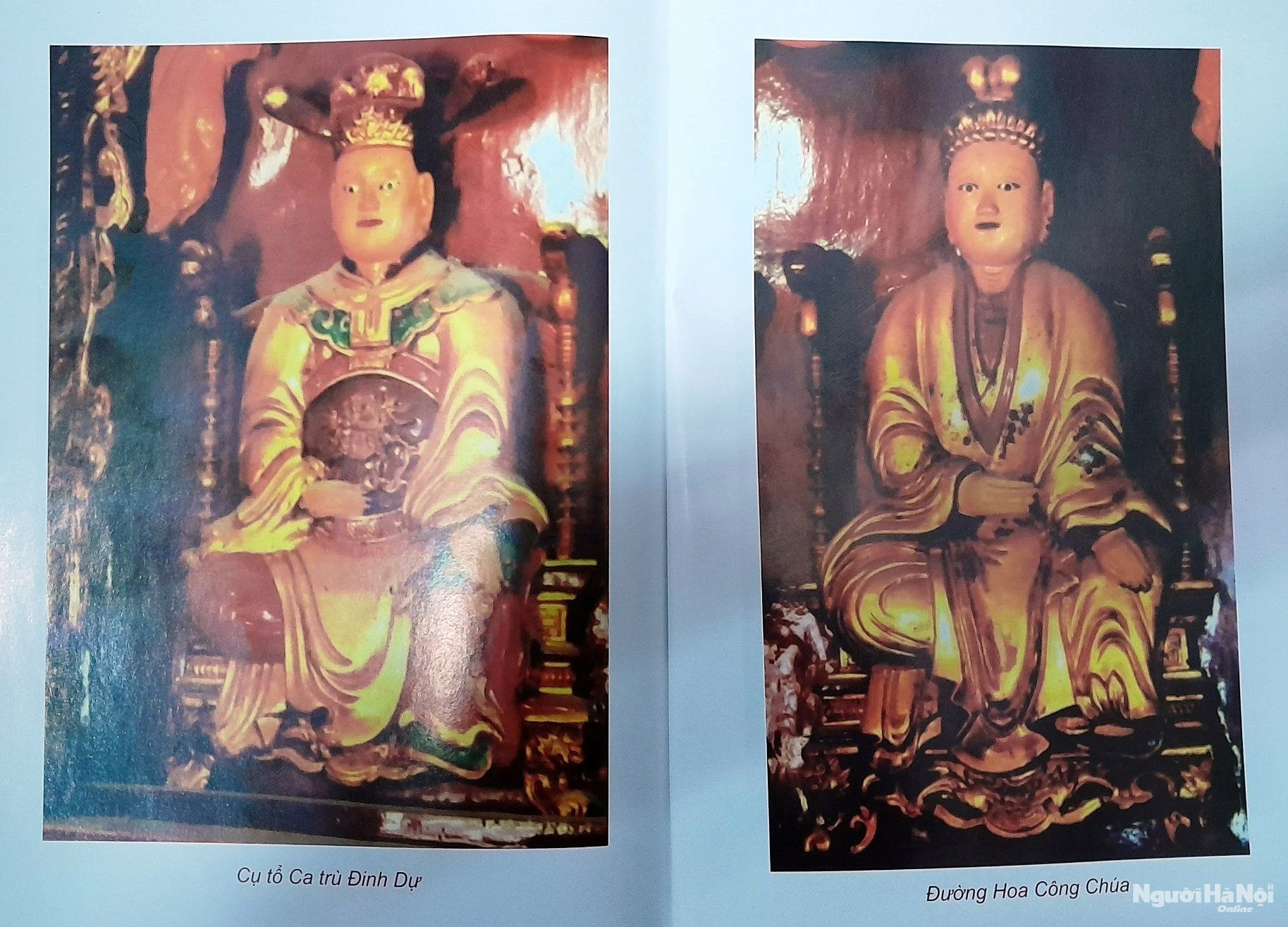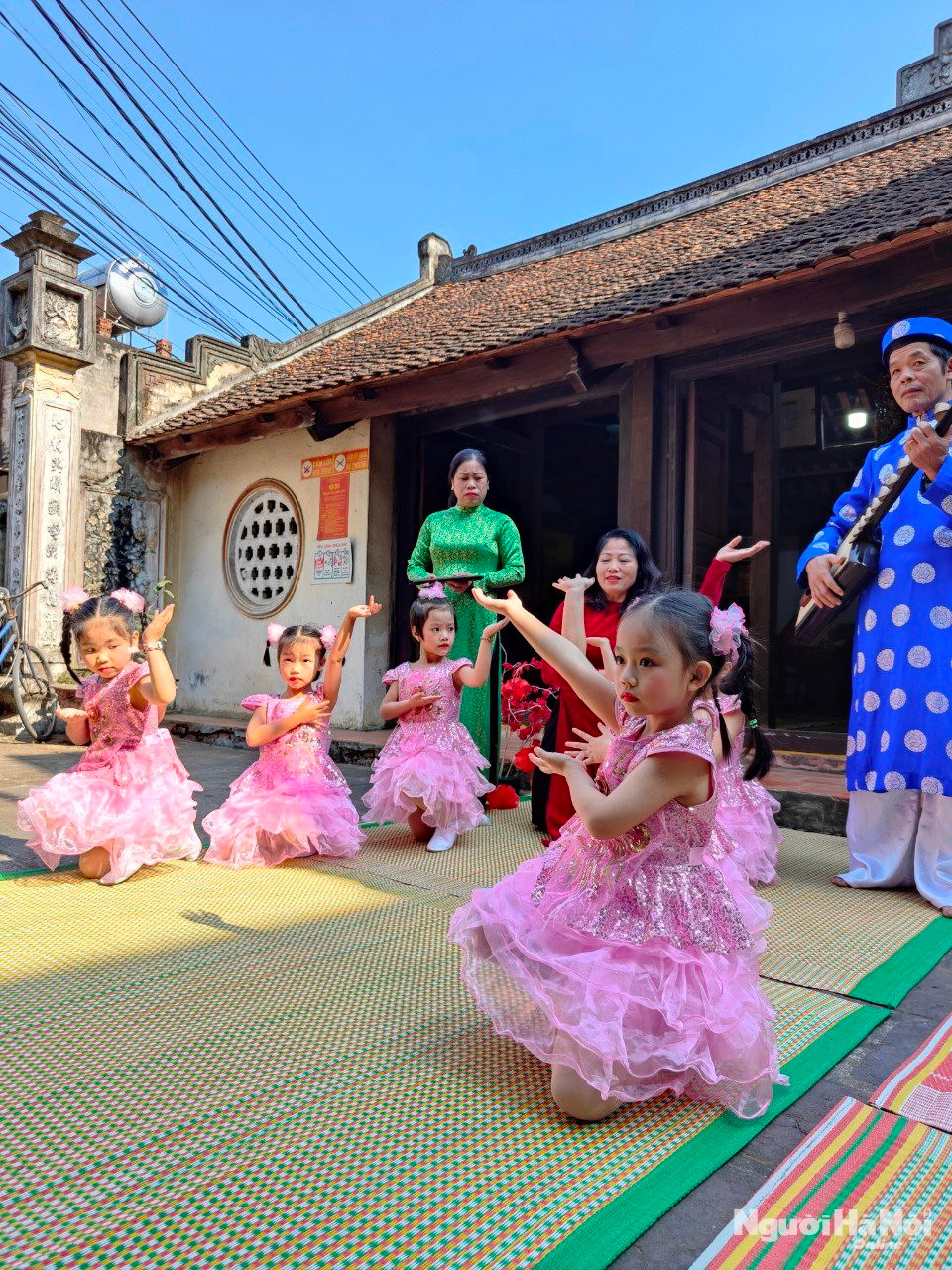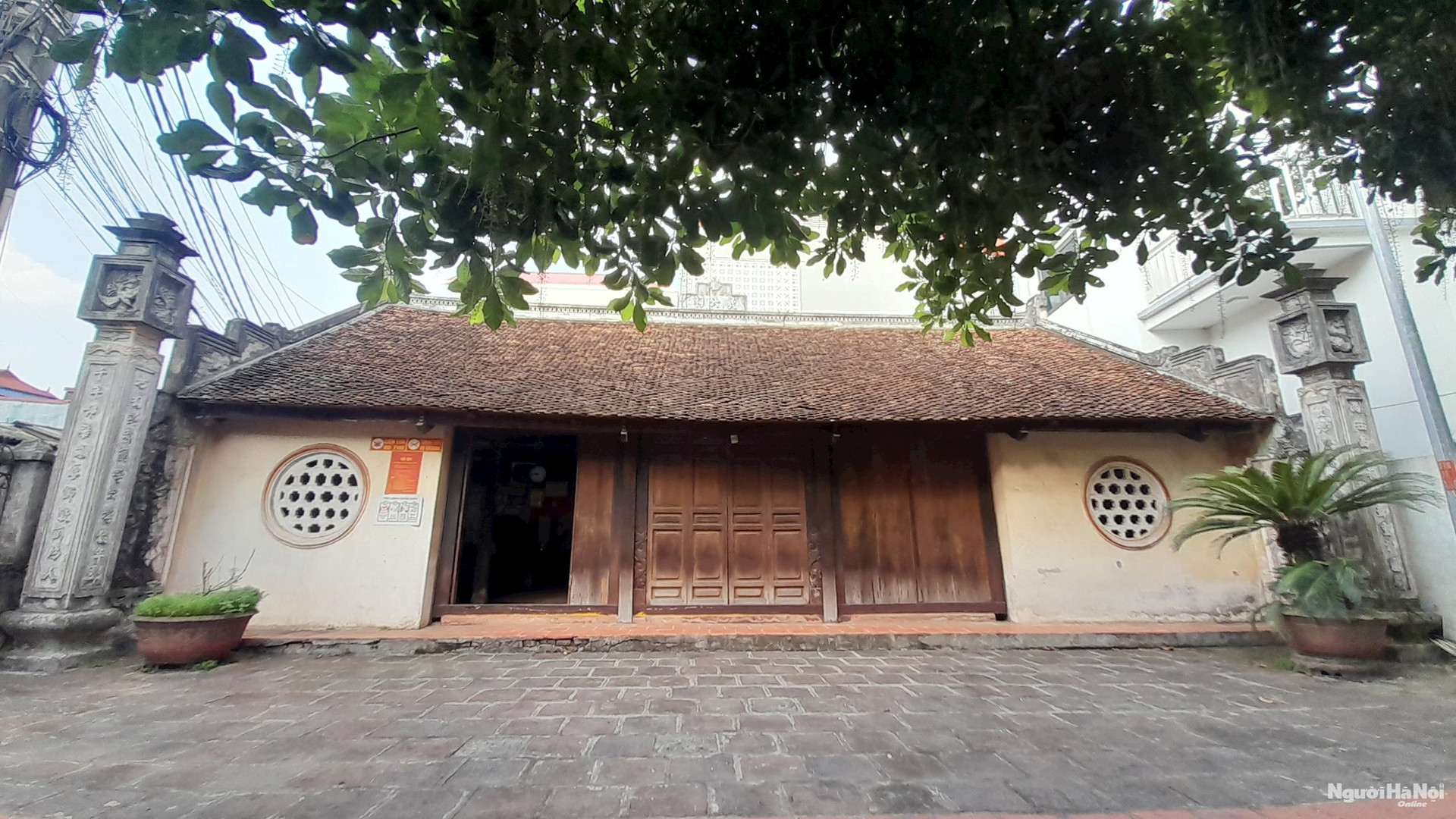Lo Khe village (Lien Ha commune, Dong Anh district, Hanoi) stands as the cradle of the nation’s Ca Tru singing art. With a history spanning over 600 years, Ca Tru singing in Lo Khe maintains its distinctive character, preserved and thriving amidst the modern pace of life.

A Ca Tru singing artisan from Lo Khe performing at the Founding master temple.
The Vietnamese Ca Tru Singing Cradle with a History of over 600 Years
During the feudal era, Lo Khe was a region in the Dong Ngan district, under the jurisdiction of Tu Son and part of the Kinh Bac region. Later, it evolved into a hamlet within Lien Ha commune, Dong Anh district, part of Hanoi. Traces of Ca Tru singing in Lo Khe are still preserved at the founding master temple, constructed in 1430 to worship the founders of the art form. The temple houses two meticulously crafted wooden statues, Dinh Du and Duong Hoa, representing the art founders, along with a box containing royal seals made of lacquered and gilded wood, bestowed by the Nguyen dynasty kings.
According to Mr. Nguyen The Dam, the head of the Ca Tru Singing Club of Lo Khe, since the 15th century, this locale had specialized parishes that performed across various districts, collectively forming the Kinh Bac region and the imperial citadel of Thang Long. During the two wars of national defense, the people of Lo Khe opened Ca Tru singing venues in the central districts of the capital. The first half of the 20th century is considered the golden age of Ca Tru singing in Lo Khe. Many renowned female singers and instrumentalists were born in Lo Khe, including Pham Thi Mui, Nguyen Thi Diem, Nguyen Thi Tinh, and distinguished instrumentalists such as Nguyen Thi Van, Nguyen Thi Nam, Nguyen The Bam, and Nguyen Van Tieu.

The founding masters of Ca Tru Singing in Lo Khe.
The genesis and birth of Ca Tru singing in Lo Khe are intertwined with historical anecdotes. It is recounted that Dinh Du, the son of Mr. Dinh Le (the most skilled general of Lam Son righteous army during the reign of King Le Loi), was born and raised in a culturally rich village in the Kinh Bac region, where he developed a passion for singing and playing instruments from a young age.
In his youth, he became renowned across the region for his exceptional musical and vocal talents. On a picturesque spring outing to Thien Thai Pagoda, Dinh Du serendipitously encountered a young woman named Duong Hoa Thien Hai, whose beauty was described as “modest moon, jealous flower,” and who possessed exceptional musical skills. The two hearts aligned, resulting in a destined union. They subsequently moved to Lo Khe and together pioneered the art of Ca Tru singing.
With the approval of their parents, the couple established a teaching center for singing and playing instruments, attracting participation from 12 lineages and 11 villages in neighboring districts such as Dong Ngan, Dong Anh, Tien Du, Yen Phong, and others. After Dinh Du’s passing, to preserve the tradition, two individuals, Nguyen Van and Nguyen The, continued the teaching legacy and founded the Hoang Phu facility, the largest in the region today.
The Distinctive Charm of Ca Tru Singing in Lo Khe
The art of Ca Tru singing is not exclusive to Lo Khe but also prevails in many other areas of Hanoi and various provinces and cities throughout Vietnam, including Phu Tho, Vinh Phuc, Bac Giang, Bac Ninh, Hai Phong, Hai Duong, Hung Yen, Nam Dinh, Thai Binh, Ninh Binh, Thanh Hoa, Nghe An, Ha Tinh, and more. However, according to the venerable folk artist Pham Thi Dien, a pillar of Ca Tru singing in Lo Khe at the age of 80, in some places, Ca Tru singing is often performed casually or in a festive manner. In contrast, Ca Tru singing in Lo Khe maintains the traditional style of temple singing, instrumental performances, and rhythmic patterns, demanding a high level of seriousness from female singers, instrumentalists, and drummers. The female singers must sing with precise enunciation.
.jpg)
Artisans, instrumentalists, and drummers of the Lo Khe Ca Tru Singing Club engage in regular activities twice a month. (Photo provided by the individuals)
Lo Khe is a village with a longstanding tradition of temple singing. Annually, temple singing, also known as “cua dinh,” is organized at the village temple during the opening ceremony of the village festival honoring the deities and the village guardian spirit. Cua dinh comprises 15 different styles, with strict and ceremonial singing rules. The singing must follow the rhythms of ritual movements and gestures performed by the worshippers. The temple singing style is also known as “giai.” It involves duo singing and recitation. The duo singing is called “cau mot” (muou), and the recitation is known as “ha lieu.” When the duo sings one phrase, followed by the recitation of one phrase, it is referred to as “dao luon kep voi.”
The singing technique requires clear enunciation, ample breath, and a resonant voice to ensure everyone can hear distinctly. The performance must be precise, avoiding a lax or monotonous style, and maintaining a balance between loud and soft tones. The selected temple singing pieces often involve serious and profound themes, discussing historical events, and legendary figures, portraying landscapes, and strictly avoiding songs with romantic or affectionate lyrics. Female leaders take turns singing, and the singing session, known as “chau,” lasts from 9 p.m. until the morning, constituting one chau.
While the Cua Dinh singing in Lo Khe adheres to a rigorous and respectful discipline, the instrumental accompaniment is relaxed, lacking the complexity found in ceremonial singing. The distinguishing feature of temple singing is its grandeur, solemnity, and sacredness. “In Lo Khe, a Ca Tru singing piece may contain up to 36 vocal variations, with the tonality shifting every few phrases. Some classical Ca Tru singing works, such as thet nhac, ty ba singing, cung Bac, Chuc ho, etc., demand highly intricate singing techniques and can extend for 30 to 40 minutes. Ca Tru singing in Lo Khe still preserves ancient Ca Tru singing pieces with challenging melodies. Additionally, Lo Khe Ca Tru singing not only involves singing but also incorporates various dance movements,” shared folk artist Pham Thi Dien.
For example, the ritual dance offering involves four young performers who simultaneously dance and sing. In the ritual dance known as “bo bo,” typically, four young performers take their positions in the four corners, singing and dancing in unison. Outside, someone plucks the bottom strings of a Dan Day (a traditional Vietnamese instrument), while the senior singer taps the phach (a bamboo percussion instrument) to maintain rhythm and guide the pitch changes. The content of the “bo bo” singing and dancing reflects the lively activities of the villagers before the altar.
In the dance dedicated to the altar, four young performers dance to the melody of Luu thuy bat am while officials offer wine to the altar, with no singing involved. On the other hand, the “Tu linh” dance consists of four groups arranged in a square formation, moving to the rhythm of Luu thuy or “Tung choac” music. The “Bong it” dance requires at least eight leading female dancers, especially chosen for their youth and beauty, resembling flowers in front of the altar. In more formal settings, the number can increase to 16, or even up to 32 during major ceremonies. This dance follows musical cues for precision, with the pace dictated by the music. When turning, performers only rotate half their body and never turn their backs to the altar.
Preservation and Development Efforts
Amid the influences of modern societal life and the influx of contemporary entertainment forms, Ca Tru singing in Lo Khe faces the risk of fading away. The ancient pieces and melodies are at risk of being lost, primarily because skilled artisans are mostly elderly, and their art is gradually diminishing.

The transmission of Ca Tru singing to the younger generation in Lo Khe village has been maintained and pursued for many years.
However, driven by passion and dedication to rebuild, sustain, and develop the distinctive traditional art form of their ancestors, since 1995, the female singers and instrumentalists of Lo Khe have come together to establish the Ca Tru Singing Club of Lo Khe. The club currently boasts nearly 40 members, including many proficient in singing, playing instruments, and percussion. Notable figures include folk artisan Pham Thi Man, singers Nguyen Thi Thao, Hoang Thi Thu, Dinh Thi Van, and Nguyen Thi Huyen; instrumentalists Pham Van Phong, Nguyen Van Xuan, and Nguyen Van Tuyen. Notably, the club is home to Thuc Trinh, a 15-year-old singer with a soaring voice who has won numerous prestigious awards in arts festivals dedicated to Ca Tru singing at both the capital and national levels.
“In the past, mastering the art of Ca Tru singing took decades of study; now it’s more convenient because people have smartphones for recording and listening. Therefore, diligent study and love for Ca Tru singing can lead to proficiency in just a few months,” shared folk artisan Pham Thi Dien. “Currently, I am training some young enthusiasts to play the dan day, and they are enthusiastic learners, already mastering basic melodies, with some even capable of singing.”

The founding master temple, where the Ca Tru Singing Club of Lo Khe is active, has been officially recognized as a “National Historical Monument” by the Ministry of Culture, Information, and Tourism.
To preserve the art of Ca Tru singing in Lo Khe, the local government of Lien Ha commune provides a dedicated space for the club’s activities at the founding master temple. The club meets twice a month. Additionally, local authorities and cultural institutions occasionally invite the club to perform for political missions, historical sites, Ca Tru singing festivals, etc. On such occasions, the club organizes impromptu rehearsals and performances as per the requests. For several years, the district government of Dong Anh has collaborated with the club to conduct Ca Tru singing teaching classes for the younger generation in the area, contributing to the conservation and development of this urgently protected intangible cultural heritage recognized by UNESCO. It is hoped that with the efforts of these artisans, the intergenerational transmission of the “local specialty” will continue to safeguard and promote the precious cultural heritage left by their ancestors.
Hoa Quynh
Bài 4: Ca Tru singing Lo Khe – xứng danh cái nôi Ca Tru singing Việt (nguoihanoi.vn)

